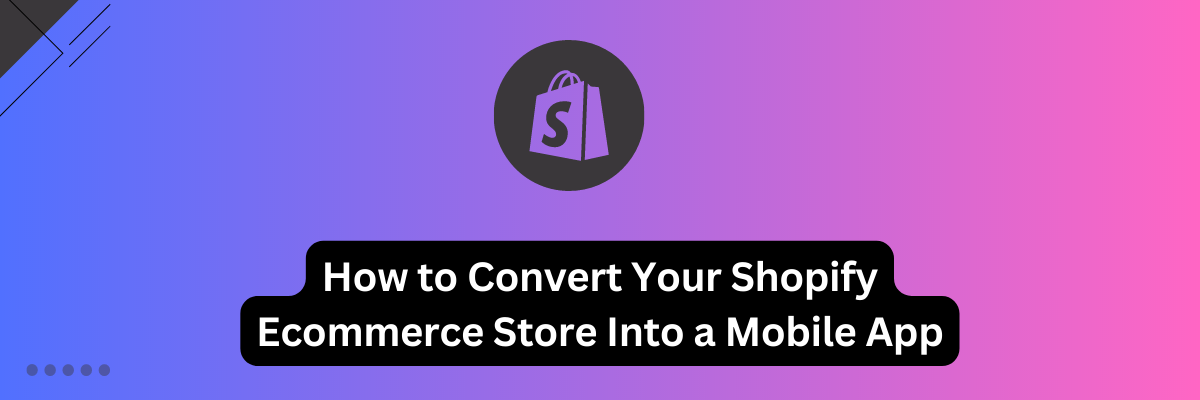
Converting your Shopify ecommerce store into a mobile app can be a great way to provide a more streamlined and user-friendly shopping experience for your customers. There are a few different approaches you can take to achieve this. Here's a step-by-step guide to help you get started:
Option 1: Use a Mobile App Builder:
-
Choose a Mobile App Builder: There are several app builders available that allow you to create mobile apps without coding. Some popular options include BuildFire, Appy Pie, and Shoutem. These platforms provide templates and drag-and-drop features to simplify the app creation process.
-
Sign Up and Create an Account: Register for an account on your chosen app builder platform.
-
Select an App Template: Most app builders offer pre-designed templates. Choose a template that matches the branding and style of your Shopify store.
-
Customize the Design: Use the app builder's tools to customize the design of your app. You can add your logo, choose colors, and arrange the layout of various app sections.
-
Integrate Your Shopify Store: Connect your Shopify store to the app builder using the provided integration options. This typically involves entering your Shopify store's API credentials.
-
Add Product Listings: Import your product listings from Shopify into the app builder. Make sure to include product images, descriptions, prices, and any other relevant information.
-
Set Up Payment Gateways: Configure the payment gateways in your app to allow customers to make purchases using the same methods available on your Shopify store.
-
Test Your App: Use the app builder's preview or testing features to ensure that the app works smoothly and displays your products correctly.
-
Publish Your App: Once you're satisfied with the app's design and functionality, you can publish it to app stores like the Apple App Store and Google Play Store.
Option 2: Hire a Mobile App Development Team:
-
Define Your Requirements: Outline the features and functionality you want in your mobile app. Consider whether you need additional features beyond what a simple app builder can provide.
-
Hire a Development Team: Look for experienced mobile app developers or development agencies that specialize in ecommerce apps. Platforms like Upwork, Freelancer, and Toptal are good places to find freelance or contract developers.
-
Share Your Shopify API: Provide your chosen development team with access to your Shopify store's API. This will allow them to integrate your store's products, inventory, and other data into the app.
-
Design and Development: Work closely with the development team to design the app's user interface (UI) and user experience (UX). They will develop the app based on your requirements and design preferences.
-
Testing and Iteration: Thoroughly test the app to identify and fix any bugs or issues. This may involve multiple rounds of testing and refinement.
-
Integrate Payment Gateways: Ensure that the app integrates with the same payment gateways you use on your Shopify store.
-
App Store Submission: Once the app is fully tested and refined, submit it to the app stores for review and approval.
-
Launch and Promotion: Once the app is live on app stores, promote it to your existing customer base through email marketing, social media, and your Shopify store itself.
Option 3: Use a Shopify Mobile App Plugin:
Shopify offers plugins and integrations that allow you to convert your store into a mobile app more seamlessly. Some popular options include:
-
Shopney: This plugin connects your Shopify store to a mobile app and provides customization options.
-
Plobal Apps: Plobal Apps offers a solution to create a branded mobile app for your Shopify store.
-
Tapcart: Tapcart provides tools to design and launch a mobile app for your Shopify store.
The steps for using these plugins generally involve signing up, connecting your Shopify store, customizing the app's design, and then publishing the app to app stores.
General Tips:
-
Branding Consistency: Ensure that the design and branding of your app are consistent with your Shopify store to provide a seamless experience for your customers.
-
User Experience: Prioritize a user-friendly and intuitive interface to enhance the shopping experience on the app.
-
Mobile Optimization: Optimize images, content, and features for mobile devices to ensure fast loading times and smooth navigation.
-
Regular Updates: Continuously update your app to add new features, improve performance, and fix any bugs.
Converting your Shopify store into a mobile app can be a valuable investment, but it's important to carefully consider your budget, goals, and the technical expertise required for each option.

 Register
Register Sign in
Sign in



